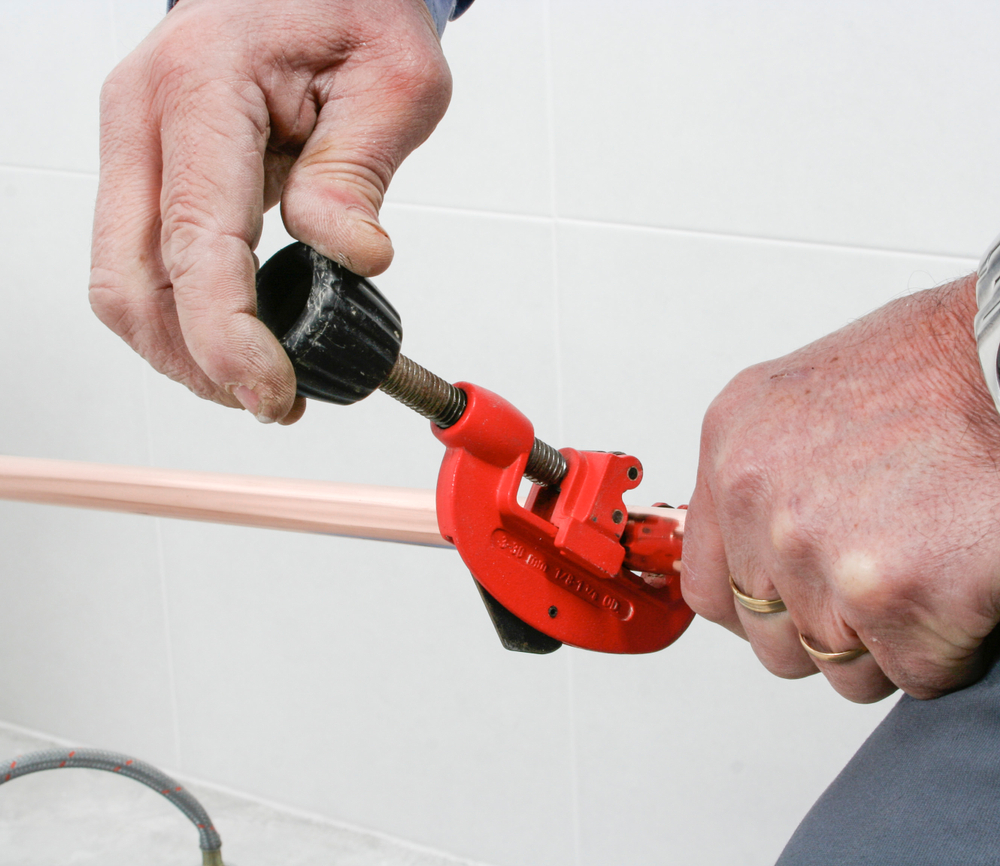Polyvinyl chloride (PVC) pipe is the pro plumber’s tubing of choice; the durable yet lightweight material is ideal for plumbing projects, big or small. If you’re unfamiliar with the stuff, PVC pipes are those ubiquitous grey or white plastic tubes you see twisting under the sink or snaking their way through the basement.
Whether you’re embarking on a DIY bathroom project or doing emergency plumbing repairs, you need to learn how to work with the material. Putting the pieces together is relatively straightforward as you’ll find fittings in your hardware store to create a watertight seal.
This three-part guide will cover the most common and effective PVC pipe cutting tools and discuss the correct way to use them. Then, to ensure you’ll finish with a nice tight seal, we’ll show you how to smooth down the burrs.
Lubing up Your Cuts
Regardless of which method you opt for, it’s worth lubricating your PVC pipe before cutting begins. Lubrication makes cutting more manageable for every material type, including PVC. An oily upper layer reduces friction to let the blade slice through the surface and prevents tiny particles from floating through the air.
So which sort of lubricant works best? We find specialist silicone-based lubricants respond well with PVC, and the classic WD40 is hard to beat. If you don’t have any lying around the house and want to get started straight away, a dab of extra virgin olive oil will do in a pinch.
Avoid using any harsh chemical lubricants that eat away at the brittle plastic. And only apply a small dab or spray to the cut line—there’s no point lubing up the entire pipe as you’ll be left with an oily mess.
How to Cut PVC Pipe: Three Common Methods
We’ll show you how to cut PVC pipe quickly and safely using the three most effective household tools: a handheld pipe cutter, a handsaw, and a miter saw. Although each option has distinct pros and cons, the best choice for you could depend on what you already have access to.
How to Cut PVC Pipe Using a Handheld Piper Cutter

Handheld pipe cutters are a simple and cost-effective solution for slicing through thin PVC pipes. But not all these tools are suitable for all PVC pipe types, so you’ll need to pay attention to the recommended cutting dimensions.
The big drawback is handheld tools are laborious for extended use. If you only need to cut a few PVC pipes, these do the trick. But should you need to slice dozens of them, the constant clamping will give you cramps in your hands.
Aim to do your cutting when it’s at least 50°F. Any colder than that, and the dry, frigid air will compromise the PVC, and the blade could crack the brittle pipe.
The Rotating Pipe Cutter
A rotating pipe cutter is a quick and convenient option when you only need to cut thin PVC piping with a diameter between appropriately 1/8” and 5/8”. These cost-effective tools look similar to pliers and come with a sharp blade attached to one side.
- Mark your cutting lines.
- Lubricate the cutting lines.
- Place the pipe on a stable surface like a workbench or sawhorse.
- Align the blade with the cut mark.
- Squeeze the handles together.
- Rotate the tool around the pipe.
Gunpla makes a cheap and effective rotating cutting tool that’s good for pipes up to 5/8” thick.
The Ratcheting Pipe Cutter
If you’re cutting anything thicker than 5/8”, you’ll need a more powerful tool than the aforementioned rotating device. The next step up is the ratcheting PVC pipe cutter, where a handy ratchet mechanism has you continually hack away the pipe for a clean cut.
- Mark your cutting lines.
- Lubricate the cutting lines.
- Place the pipe on a stable surface.
- Align the blade with the cutting mark.
- Squeeze the handle to force the blade into the surface of the pipe.
- Release the handle.
- Squeeze the handle again and repeat until you’ve cut through the pipe.
RIDGID makes a tough ratcheting pipe cutter that works well on PVC up to 1-5/8” thick.
The Rotary Pipe Cutter
Not to be confused with the rotating pipe cutter, the rotary cutter uses a spinning blade to slice through thick PVC pipe between 2 and 4” in diameter. These robust devices will set you back a significant sum, so switch over to a handsaw if you’re on a budget.
- Mark your cutting lines.
- Lubricate the lines.
- Set the groove in the cutter to the desired size.
- Insert your pipe and align the cut line.
- Turn the handle clockwise to push the blade into the pipe.
Rigid also does an excellent rotary pipe cutter, this time suitable for PVC between 1-1/2 and 4 inches thick. This particular model works well on copper piping too.
How to Cut PVC Pipe Using a Handsaw

Every self-respecting DIY guru will already have a handsaw in their war chest of tools, making this one of the most popular options for cutting PVC. But a word of warning: it’s also one of the messiest as handsaws tend to leave lots of rugged burrs.
Pretty much any kind of handsaw will do the trick, though the hacksaw is the simplest option to use. Sawing is always much easier using a miter box as you’ll get a clean, precise cut every time, even if you don’t have a steady hand.
- Mark your cutting lines.
- Lubricate the lines.
- Place the pipe in the miter box or on a stable surface.
- Slowly mark the cutting line with the saw.
- Saw back and forth until you’ve cut through the pipe.
Keep a close eye on the blade to ensure it doesn’t stray off course. Don’t exert downward pressure—the idea is to rock the saw back and forth.
CRAFTSMAN makes a high-quality handsaw that’s great for cutting PVC.
How to Cut PVC Pipe Using a Miter Saw

The electric miter saw is a carpenter’s best friend as these powerful cutting machines make quick work of wood. And for the home plumbing project, they’re equally effective on PVC pipes.
The downside is these heavy-duty machines require a significant financial outlay, so it’s not a viable option if you need to do a few quick cuts. But if you’ll be cutting through PVC (and various other materials) on the reg, it might be worth purchasing one of your own. Many big-box and home hardware stores rent out miter saws by the day, which is worth considering if you need to cut lots of PVC pipes as a one-off job.
- Mark your cutting lines.
- Lubricate the cutting lines.
- Position the pipe against the miter saw fence.
- Align the blade with the cutting line.
- Lift the saw and turn on the electric blade.
- Lower the blade slowly to cut through the pipe.
- Turn the blade off.
- Lift the saw and remove the pipe.
If you can’t cut through the entire pipe on your first attempt, lift the blade and turn it off before trying again. Adjusting the pipe while sawing can be dangerous and makes for a messy cut.
DEWALT does an awesome 12-inch miter saw that slices through PVC pipe like butter. To reduce the occurrence of burrs, you could add a fine-toothed blade. Load it in backward and cut through the PVC as slow as possible to further reduce burrs.
Getting Rid of Burrs
Burrs are an unwanted consequence of every PVC gig, no matter how carefully you cut. Factor in time at the end to smooth burrs down and ensure an optimal fit. If not, you could be looking at nasty leaks and clogs further down the track.
One practical method is to slice back the inner and outer rim with a sharp utility knife. If you hold the blade at an angle, you’ll find it’s easier to glide across the rim.
The other option is to sand the burrs off with 120-grit sandpaper. You only need to smooth out the burrs—be careful not to sand too far, or you could compromise the fit.
How to Cut PVC Pipe: Final Thoughts
Cutting PVC pipe is a simple task that a novice DIYer can pull off.
In this guide, we’ve shown you how to slice through the stuff using the three most common tools: a pipe cutter, a handsaw, or a miter saw. Remember to smooth back the burrs at the end to achieve a nice watertight fit.
